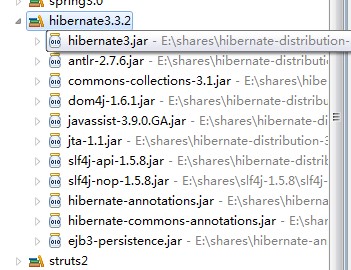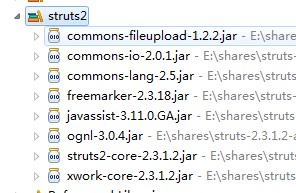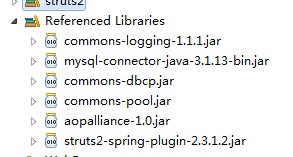struts spring hibernate整合
最近等著專案啟動,沒事情幹,把struts2 spring hibernate 又複習了一遍,參考資料是尚學堂-馬老師的視訊講解,感覺很到位,現在把整合的步驟給大家公佈出來,有問題和疑問的大家可以進來討論。
專案所需要的jar包,一共分4部分,spring.jar,hibernate.jar,struts2.jar和其他一些輔助jar(reference.jar)
第一個jar spring的,版本是spring-framework-3.1.0.RELEASE

第二個是hibernate.jar,版本是hibernate-distribution-3.3.2.GA-dist,這裡需要說明的是hibernate現在新的版本是4,但是我在整合的時候老是找不到cacheprovide這個類,其實hibernate4照3還是有比較大的改動的,這裡就不討論了。

第三個是struts2.jar 版本是struts-2.3.1.2 沒有把所有的struts2的jar都匯入進來,匯入的是struts2的jar包中有個例子程式struts-bank裡面的jar包,除了asm都匯入進來了

第四個是reference.jar 這裡面主要是日誌,資料庫連線的包,struts-spring-plugin-2.3.1.2.jar這個包其實是struts2的包,但是這裡我把它放在外面是為了管理方便,因為我用了user libraries把jar分開了,這樣看著方面點。

在囉嗦幾句,我是把每一個分別搭好最後再整合一起的,包括spring和hibernate2的整合。導包時要注意寧可少包不能多加包,因為加多了會出現一些莫名其妙的錯誤。你可以看缺少哪個在引入哪個。
幾個重要的配置檔案:web.xml bean.xml(就是spring的配置檔案,一般名字為applicationContext.xml) struts.xml
web.xml 要web容器把spring的配置檔案都載入進去,就要使用
<listener>
<listener-class>org.springframework.web.context.ContextLoaderListener</listener-class>
</listener>
讀配置檔案的方法是
<context-param>
<param-name>contextConfigLocation</param-name>
<param-value>classpath:bean.xml</param-value>
</context-param>
多個配置檔案應該是中間加空格就可以了,具體的我沒試過,找機會試一下。
<?xml version="1.0" encoding="UTF-8"?>
<web-app version="2.5" xmlns="http://java.sun.com/xml/ns/javaee"
xmlns:xsi="http://www.w3.org/2001/XMLSchema-instance"
xsi:schemaLocation="http://java.sun.com/xml/ns/javaee
http://java.sun.com/xml/ns/javaee/web-app_2_5.xsd">
<context-param>
<param-name>contextConfigLocation</param-name>
<param-value>classpath:bean.xml</param-value>
</context-param>
<listener>
<listener-class>org.springframework.web.context.ContextLoaderListener</listener-class>
</listener>
<!--
or use the ContextLoaderServlet instead of the above listener
<servlet> <servlet-name>context</servlet-name>
<servlet-class>org.springframework.web.context.ContextLoaderServlet</servlet-class>
<load-on-startup>1</load-on-startup> </servlet>
-->
<filter>
<filter-name>struts2</filter-name>
<filter-class>org.apache.struts2.dispatcher.ng.filter.StrutsPrepareAndExecuteFilter</filter-class>
</filter>
<filter-mapping>
<filter-name>struts2</filter-name>
<url-pattern>/*</url-pattern>
</filter-mapping>
<welcome-file-list>
<welcome-file>index.jsp</welcome-file>
</welcome-file-list>
</web-app>bean.xml 這裡面把hibernate的sessionFactory也配置進去了,還加了事務的,注意這裡用的是註解的方式annotation,比較方便
<?xml version="1.0" encoding="UTF-8"?>
<beans xmlns="http://www.springframework.org/schema/beans"
xmlns:xsi="http://www.w3.org/2001/XMLSchema-instance" xmlns:aop="http://www.springframework.org/schema/aop"
xmlns:tx="http://www.springframework.org/schema/tx"
xsi:schemaLocation="http://www.springframework.org/schema/beans
http://www.springframework.org/schema/beans/spring-beans-3.0.xsd
http://www.springframework.org/schema/tx http://www.springframework.org/schema/tx/spring-tx-2.5.xsd
http://www.springframework.org/schema/aop http://www.springframework.org/schema/aop/spring-aop-2.5.xsd">
<!-- more bean definitions for data access objects go here -->
<bean id="baseDao" class="com.mf.spring3.dao.impl.UserDaoImpl">
<property name="sessionFactory" ref="sessionFactory"></property>
</bean>
<bean id="userDao" class="com.mf.spring3.dao.impl.UserDaoImpl">
<property name="sessionFactory" ref="sessionFactory"></property>
</bean>
<bean id="logDao" class="com.mf.spring3.dao.impl.LogDaoImpl">
<property name="sessionFactory" ref="sessionFactory"></property>
</bean>
<bean id="userService" class="com.mf.spring3.service.impl.UserServiceImpl">
<property name="userDao" ref="userDao"></property>
<property name="logDao" ref="logDao"></property>
</bean>
<bean id="logService" class="com.mf.spring3.service.impl.LogServiceImpl">
<property name="logDao" ref="logDao"></property>
</bean>
<bean id="userAction" class="com.mf.spring3.action.UserAction">
<property name="userService" ref="userService"></property>
</bean>
<bean id="myDataSource" class="org.apache.commons.dbcp.BasicDataSource"
destroy-method="close">
<property name="driverClassName" value="com.mysql.jdbc.Driver" />
<property name="url" value="jdbc:mysql://localhost/springhibernate" />
<property name="username" value="root" />
<property name="password" value="root" />
</bean>
<bean id="sessionFactory"
class="org.springframework.orm.hibernate3.annotation.AnnotationSessionFactoryBean">
<property name="dataSource" ref="myDataSource" />
<!--
<property name="annotatedClasses">
<list>
<value>com.mf.spring3.model.User</value>
<value>com.mf.spring3.model.TLog</value>
</list>
</property>
-->
<property name="packagesToScan">
<list>
<value>com.mf.spring3.model</value>
</list>
</property>
<property name="hibernateProperties">
<value>
hibernate.dialect=org.hibernate.dialect.MySQLDialect
</value>
</property>
</bean>
<tx:annotation-driven transaction-manager="myTxManager"/>
<bean id="myTxManager"
class="org.springframework.orm.hibernate3.HibernateTransactionManager">
<property name="sessionFactory" ref="sessionFactory" />
</bean>
</beans>struts.xml 需要注意的地方:<action name="login" class="userAction" />這裡面的class不是類的路徑,而是spring中配置的bean的id名
<?xml version="1.0" encoding="UTF-8" ?>
<!DOCTYPE struts PUBLIC
"-//Apache Software Foundation//DTD Struts Configuration 2.0//EN"
"http://struts.apache.org/dtds/struts-2.0.dtd">
<struts>
<constant name="struts.devMode" value="true" />
<constant name="struts.objectFactory" value="org.apache.struts2.spring.StrutsSpringObjectFactory" />
<package name="default" namespace="/" extends="struts-default">
<!--
<default-action-ref name="index" />
<global-results>
<result name="error">/error.jsp</result>
</global-results>
<global-exception-mappings>
<exception-mapping exception="java.lang.Exception" result="error"/>
</global-exception-mappings>
-->
<default-action-ref name="login"></default-action-ref>
<action name="login" class="userAction">
<result>/login/list.jsp</result>
<result name="input">/login/add.jsp</result>
</action>
</package>
<!-- Add packages here -->
</struts>
好的,剩下的就是jsp和java的類了。這兩部分就先不貼圖了。
好了,這樣就整合好了,謝謝大家!!歡迎大家進來討論
